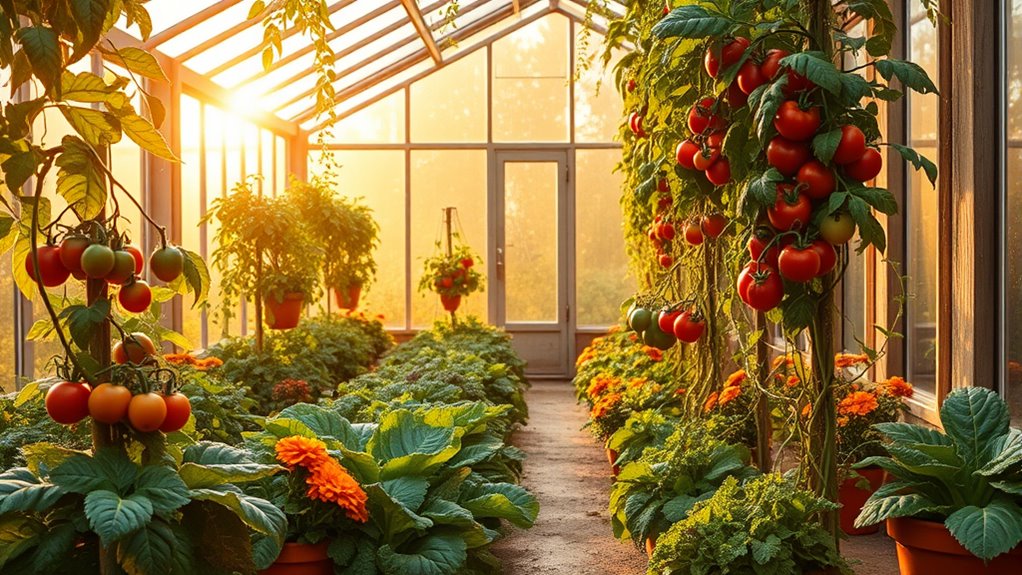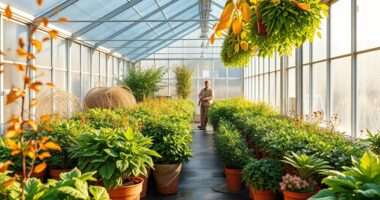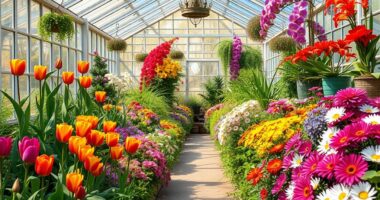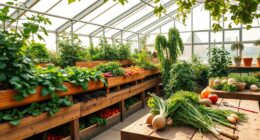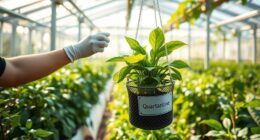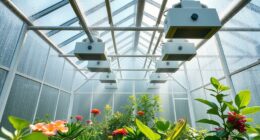To extend your harvest into autumn, set up a greenhouse to create a controlled environment that shields your plants from early frosts and reduced daylight. Use supplemental LED grow lights to mimic natural sunlight, ensuring your vegetables, herbs, and flowers stay healthy and productive. Manage pests carefully with organic methods and keep the space clean to prevent infestations. Keep these tips in mind, and you’ll discover how to maximize your fall gardening success.
Key Takeaways
- Use supplemental grow lights to compensate for shorter daylight hours and support plant growth.
- Maintain a controlled greenhouse environment to protect plants from cooler temperatures and pests.
- Extend the growing season by selecting cold-tolerant crops suitable for fall harvesting.
- Implement pest management strategies to prevent infestations that thrive in greenhouse conditions.
- Optimize lighting placement and schedules to promote flowering, fruiting, and healthy plant development in autumn.
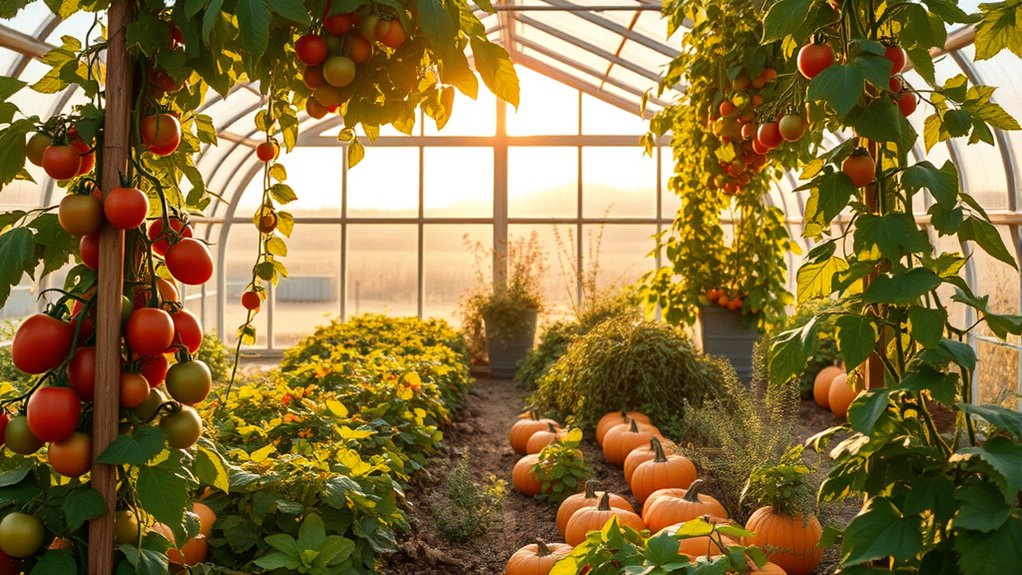
Have you considered extending your gardening season by using a greenhouse this fall? A greenhouse offers the perfect environment to keep your plants thriving well into the cooler months. With proper planning, you can enjoy fresh vegetables, herbs, and flowers even as the outside world begins to cool down. One of the key advantages of fall greenhouse gardening is the ability to control environmental factors, especially lighting and pests. As daylight hours shorten, greenhouse lighting becomes essential to guarantee your plants receive enough light for photosynthesis and healthy growth. Installing supplemental grow lights can make a significant difference, allowing you to extend the growing season and maintain peak plant health. These lights mimic natural sunlight, helping your plants produce energy and develop robustly, even on overcast days or shorter fall days.
Another critical aspect to consider is seasonal pest control. Pests tend to become more persistent as they seek warm, sheltered spots to overwinter. In a greenhouse, pests like aphids, whiteflies, and spider mites can quickly multiply if not managed properly. Implementing integrated pest management strategies helps keep these unwelcome visitors at bay. This might include introducing beneficial insects, using organic sprays, or employing physical barriers to prevent pest entry. Regular inspections are essential—catching infestations early prevents them from spreading and damaging your plants. Maintaining cleanliness inside your greenhouse also plays a role in seasonal pest control, as debris and diseased plant material can harbor pests and pathogens.
In addition to pest control, maximizing greenhouse lighting during fall is essential for plant productivity. Since natural sunlight decreases as the seasons change, supplementing with artificial lighting ensures your plants continue to receive the light they need to grow, flower, and produce fruit. Using energy-efficient LED grow lights can provide the right spectrum of light while keeping energy costs manageable. Positioning these lights correctly—above your plants and on timers—ensures consistent light exposure, mimicking the natural day-night cycle. This consistency helps prevent stress and encourages steady growth.
Frequently Asked Questions
What Are the Best Crops to Grow in a Fall Greenhouse?
For fall planting schedules, choosing the right crops is key. You should focus on seasonal crop selection like leafy greens, root vegetables, and brassicas, which thrive in cooler temperatures. These crops grow well in a greenhouse, allowing you to extend your harvest into autumn. Keep the greenhouse temperature consistent, and you’ll enjoy fresh produce even as outdoor weather cools down. Happy gardening!
How Do I Maintain Optimal Temperature and Humidity Levels?
You might think maintaining perfect temperature and humidity is tough, but proper ventilation strategies make it manageable. Regularly check your vents and adjust fans to prevent overheating or excess humidity. Use a humidifier or dehumidifier as needed to keep humidity control balanced. Consistent monitoring helps prevent mold and stress on plants. Trust that with these strategies, you’ll create an ideal environment for healthy, thriving crops all season long.
What Lighting Options Are Effective for Autumn Greenhouse Growth?
You should consider using LED grow lights for effective supplemental lighting during autumn. These lights provide the right spectrum for plant growth and are energy-efficient, making them ideal for extending your harvest. Position them to guarantee even coverage, and adjust the duration to mimic natural daylight hours. This way, you’ll promote healthy growth and maximize your greenhouse’s productivity as days grow shorter.
How Can I Prevent Pests and Diseases During Fall Gardening?
To prevent pests and diseases during fall gardening, you should start with good sanitation, removing debris and infected plants. Use companion planting to naturally repel pests and promote healthy growth. Apply natural pesticides like neem oil or insecticidal soap when needed, avoiding chemical treatments. Regularly inspect your plants for early signs of trouble, and guarantee proper airflow to reduce disease risk. Combining these strategies keeps your greenhouse healthy and productive all season.
What Are Some Tips for Extending the Growing Season Naturally?
Think of your garden like a marathon runner, steadily pushing through seasonal hurdles. To naturally extend your growing season, try cover crop strategies that protect soil and insulate roots. Incorporate composting techniques to enrich your soil, ensuring plants stay healthy longer. These methods create a resilient environment, much like a marathoner’s steady pace, allowing your crops to flourish into autumn and beyond without relying on artificial measures.
Conclusion
By extending your greenhouse gardening into fall, you can enjoy fresh produce well beyond summer. Many believe that with proper protection, plants can thrive longer than expected, and recent studies support this—showing that controlled environments can greatly boost harvest times. So, don’t let the season’s end stop your gardening efforts. With a little effort, you can prove that autumn’s chill doesn’t have to mean the end of your harvest. Keep growing and enjoy the bounty!
